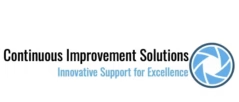Ever felt a knot in your stomach when preparing for a presentation? Or seen others powerful presentations and wondered, “how can I do that,”?
That moment when your palms start sweating just thinking about standing in front of a room full of people.
Don’t worry, you’re not alone. Not even close.
We’re going to unlock the secrets to delivering those knock-your-socks-off presentations you’ve been dreaming of (minus the stress and endless overthinking).
Let’s dive in!
Overcoming Anxiety
Here’s a mind-blowing fact: 75% of people have a fear of public speaking. That’s over 200 million Americans who get nervous at the thought of talking to a crowd!
When you feel a flutter of nerves before your next presentation, remember: You’re standing in solidarity with millions of others, including many seasoned professionals who still feel the same rush of adrenaline.
Understanding Presentation Anxiety
Let’s get real about presentation anxiety.
While some folks deal with full-blown glossophobia (a fancy word for the extreme fear of public speaking), even a mild case can throw a serious wrench in your plans.
When you’re too afraid to speak up, brilliant ideas of yours stay locked away.
Your perfect solution to the problem everyone’s facing?
It remains your little secret.
And before you know it, this fear is quietly putting the brakes on your personal growth, professional development, and your ability to make an impact in this world.
The worst part?
Each awkward or uncomfortable speaking experience reinforces that little voice saying, “Never doing that again!” Fear is sneaky. It warns you to play it safe and avoid those supposedly “risky” situations.
But here’s what’s fascinating: fear of public speaking isn’t actually about the quality of your speech. It’s about what’s happening inside you: how you feel, what you’re thinking, and how you’re acting when all eyes are on you.
So why do we freak out about speaking in public? Research points to four key factors:
- Physiology (what happens in your body)
- Thoughts (the stories you telling yourself)
- Situations (the when, where, and who)
- Skills (your public speaking toolkit)
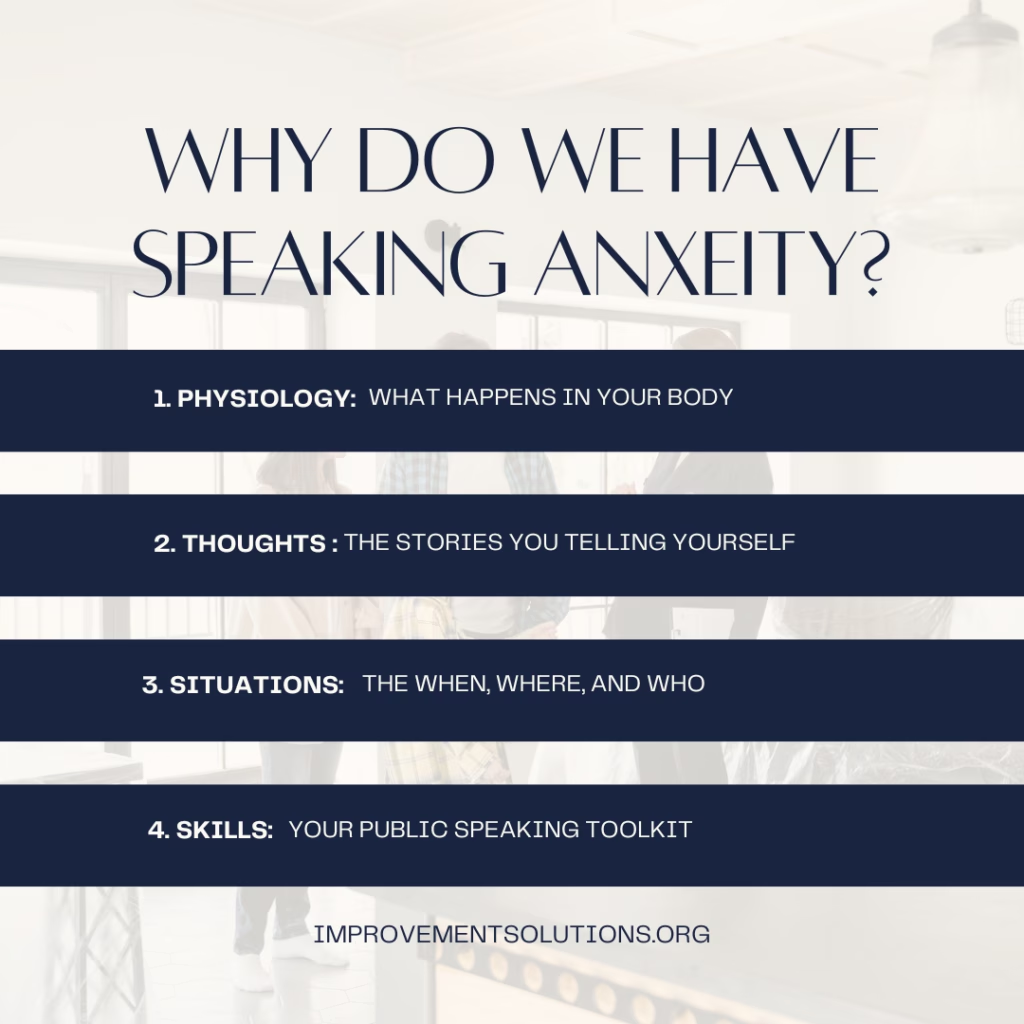
How to Manage Physical Symptoms
Let’s talk about the elephant in the room. You know, the one doing jumping jacks on your chest right before you speak.
Yep, I’m talking about those physical symptoms that come out of nowhere and make you question all your life choices the moment someone says, “You’re up next!”
Honestly?
These symptoms can feel way more intimidating than actually speaking. It’s like your body decides to throw a full-on rebellion party and forgot to send you the memo.
Suddenly, you’re dealing with:
- Chest tightness
- Sweaty palms
- Shaking hands or knees
- Shortness of breath
- A trembling voice
- Dizziness or nausea
- Muscle tension
- Blushing
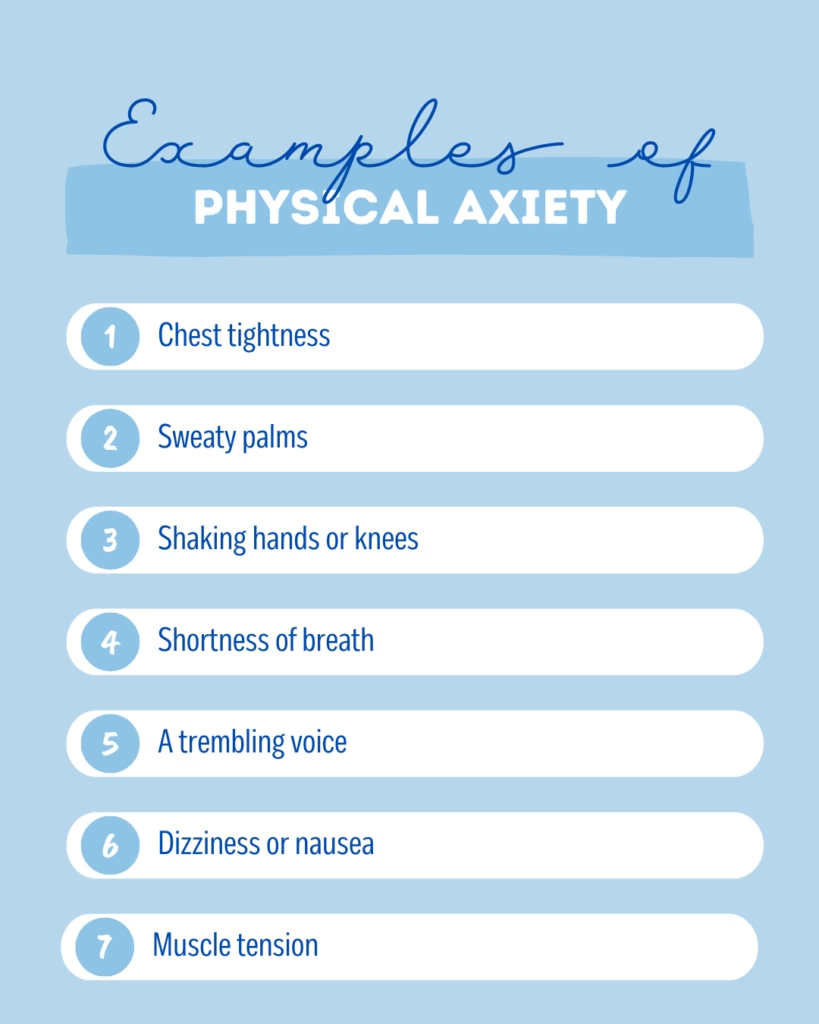
It’s a lot. And it’s real.
But here’s the good news: you’re not broken or bad at speaking. You’re human. And that overactive fight-or-flight response?
It’s trying to protect you. (Misguided? Yes. But we’ll give it an A+ for effort.)
So, now you’re about to give a presentation.
Your palms are sweaty, knees weak, arms are… okay, we’re not quite in Eminem territory, but you get the point.
The physical jitters are real.
And while the big, deep-rooted fear of public speaking takes some time and coaching to unravel, there are some quick wins for those everyday nerves that hit right before you speak.
Now, let’s be clear: if you’re experiencing severe symptoms (like panic attacks or you can’t stop vomiting) that’s your cue to reach out to a mental health professional. No presentation is worth that level of distress.
But for lesser symptoms, little things make a big difference.
1. Deep Breathing, But Make It Real
I’m not talking about the dramatic sigh when someone cuts you off in traffic.
I mean belly breathing.
The kind that makes your stomach rise and fall.
When you take slow, intentional breaths all the way into your diaphragm, it sends a signal to your nervous system: “Hey, we’re safe. No lions here.”
Try a 4-4-4 count: Inhale for 4 seconds, hold for 4, exhale for 4.
Do that a few times, and you’ll feel your body start to chill out. It’s basically nature’s built-in stress switch.
2. Flip the Script on Public Speaking
I know, I know, public speaking has a reputation.
But what if you started telling yourself a different story?
Instead of associating it with awkward silences and judgmental stares, try linking it with something positive: excitement, energy, connection, even pride.
Sounds wild? Maybe.
But your brain is surprisingly open to rebranding.
Next time you feel the adrenaline rush, tell yourself: “This isn’t fear. This is fuel. Let’s go.”
3. S-l-o-w D-o-w-n
When you’re nervous, your mouth wants to set a speed record.
But here’s the deal: speaking faster won’t get you off stage faster; it just makes you hard to follow and way more anxious.
Slow. It. Down.
Pause.
Breathe.
Let your words land like you’re dropping little knowledge bombs, not unloading a firehose of information.
You’ll sound more confident, and your brain will have time to catch up with your mouth (which is always helpful).
4. Visualize Your Victory
Before you step on stage (or into the Zoom room), take a moment.
Close your eyes and see yourself crushing it.
The audience is nodding, maybe even smiling. You’re calm, clear, and totally in control.
This isn’t some woo-woo fantasy trick. Athletes do it. Performers do it. You can do it too.
Visualization actually helps prep your brain to perform. It’s like giving your mind a sneak preview of success.
5. Shift Your Focus: From Judgment to Message
One of the sneakiest tricks of anxiety?
Making us think everyone is laser-focused on us.
Spoiler alert: they’re not.
Most people are too busy wondering if they left the stove on or how their hair looks on the office projector screen.
Instead of worrying about being judged, lock into your message.
You’re there for a reason. You’ve got something valuable to say. Focus on serving the audience, not surviving them.
That shift in mindset? Total game-changer.

Creating an Impactful Presentation
Alright, now that we’ve tackled the jitters, let’s talk about making your presentation one to remember.
You know, the kind that doesn’t just fade into oblivion after your audience politely applauds and then checks their phones.
We want impact. We want people to walk away thinking, “Wow, that was good!”
And here’s how you do it.
Structuring Your Content
Now that we’re ready to create a presentation that’s not just informative but also memorable, let’s break it down into easy steps you can follow.
Think of structuring your presentation like building a house. You need a solid foundation (the intro), strong walls (your main points), and a roof (the conclusion) that ties everything together.
Here’s how you do it:
Compelling Introductions
The intro is your chance to grab attention.
Like the first five seconds of a YouTube video that decide whether your audience stays or clicks “skip.”
You want to hook them in with something that sparks curiosity, makes them feel like they have to hear more, or even makes them laugh.
Start with a story, a surprising fact, or a bold statement.
For example, imagine you’re giving a presentation on the importance of time management, and you start with this:
“How would you feel if you knew you had 24 hours to live? Well, you kind of do because every 24 hours, a whole new day begins. The question is, how will you spend them?”
Boom! Right off the bat, you’ve got their attention. You’ve set the stage for an engaging conversation and made them think about time in a completely new way.
Organizing Main Points
Now that you’ve got their attention, let’s get to the good stuff. This is where you’ll deliver your main points.
Keep it simple and clear.
A good rule of thumb? Stick to three main points.
Why? Because humans can only absorb so much information at once, and three is the sweet spot.
For example, if you’re talking about building confidence in speaking, your three main points could be:
- Understanding your fear
- Practicing to reduce anxiety
- Shifting your mindset to embrace the challenge
Each of these points should have a clear, actionable takeaway. Think of it like a mini “to-do” list for your audience.
The goal is for them to walk away with something concrete they can implement.
Memorable Conclusions
The conclusion is your last chance to leave an impact, so make it count!
A good conclusion should wrap up your main points and leave your audience with something to think about.
You want them to walk away feeling like they’ve learned something valuable and ideally, they are inspired to take action.
Here’s a pro tip: end with a call-to-action.
It doesn’t have to be overwhelming. You could encourage them to try one suggestion you mentioned in your presentation right after they leave the room.
For example, you could say, “Next time you’re about to speak in public, take a deep breath, remind yourself you’re not alone in your fear, and then give it a shot. You’ve got this!”
And just like that, you’ve taken your audience from “I’m not sure about this” to “I can do this!” all in the course of a few minutes.
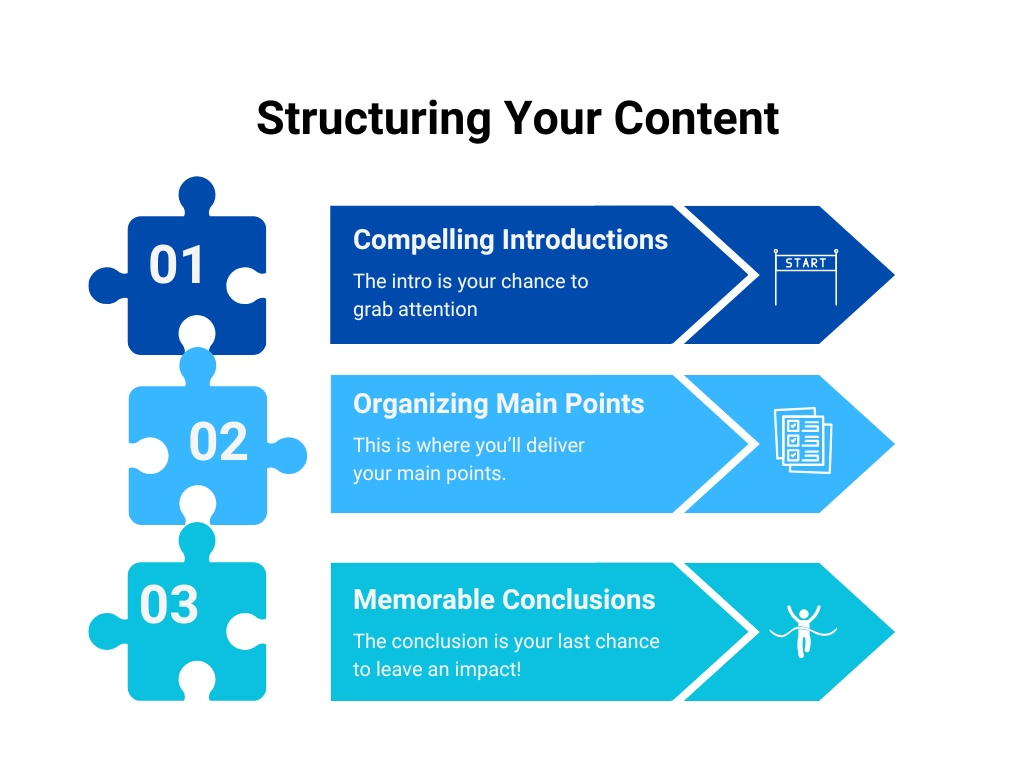
Incorporating Storytelling
Let’s talk about one of the most powerful tools in your presentation toolbox: storytelling.
Stories make your message memorable and relatable.
Think about it: when was the last time you remembered a boring list of stats? Probably never.
But I bet you remember a time someone shared a personal story about overcoming a challenge.
That’s because stories evoke emotions, and emotions are what stick with us long after the presentation ends.
Here’s an example. Let’s say you’re giving a presentation on personal growth.
Instead of just rattling off a bunch of advice, you could share a story:
“A few years ago, I was terrified of public speaking. My knees would shake, my voice would crack, and I’d avoid eye contact like it was my full-time job. But one day, I decided to embrace the fear. I started small, speaking at meetings, then at events, until one day, I was presenting to a room of 500 people. The nerves were still there, but I was in control.”
See how the story instantly humanizes the topic?
Now, your audience is thinking, “Hey, if she can do it, I can too!”
Keeping It Simple and Focused
Alright, now that we’ve got storytelling in our back pocket, let’s keep it simple and focused.
Your audience’s attention span is not as long as you think. (We’re living in a world of TikToks and 280-character tweets, people.)
So, the key to holding their attention? Don’t overload them with information.
Stick to your three main points and make sure every piece of content you present ties back to your core message.
If something doesn’t serve your overall goal, ditch it. The simpler, the better.
For instance, let’s say you’re giving a presentation on leadership. Your three points could be:
- Leading by example
- Communicating effectively
- Empowering others
Each of these points should have a clear, actionable takeaway for your audience.
If you start going off on a tangent about unrelated topics, you risk losing their focus. Keep it laser-focused so they can walk away with a clear understanding of your message.
Practice Strategies
Okay, here’s the deal: the best way to crush any presentation is by practicing until it feels like second nature.
We all know that practice makes perfect, but what does effective practice actually look like?
Let’s break it down.
Effective Practice Methods
First things first: practice isn’t just about reading through your notes over and over.
You’ve got to get in the zone like you’re actually presenting.
So, how do we make that happen?
- Stand up and deliver: Practice standing, speaking aloud, and moving around as if you were on stage. This gets your body used to the physicality of presenting and lets you practice your gestures, pacing, and eye contact. Bonus points if you pretend there’s an audience in front of you (even if it’s just your dog).
- Record yourself: Nothing will show you your strengths and weaknesses quite like watching a recording of yourself. It’s awkward at first, but trust me, it’s worth it. You’ll notice things like pacing, filler words, and gestures you never even realized you were doing. And guess what? You’ll improve every time you hit play.
- Practice with a friend: Grab a friend, family member, or coworker, and present to them like it’s the real deal. Ask for feedback (the honest kind!) on what works and what doesn’t. You’ll also get used to presenting in front of someone else, which will help with nerves when you face a bigger crowd.
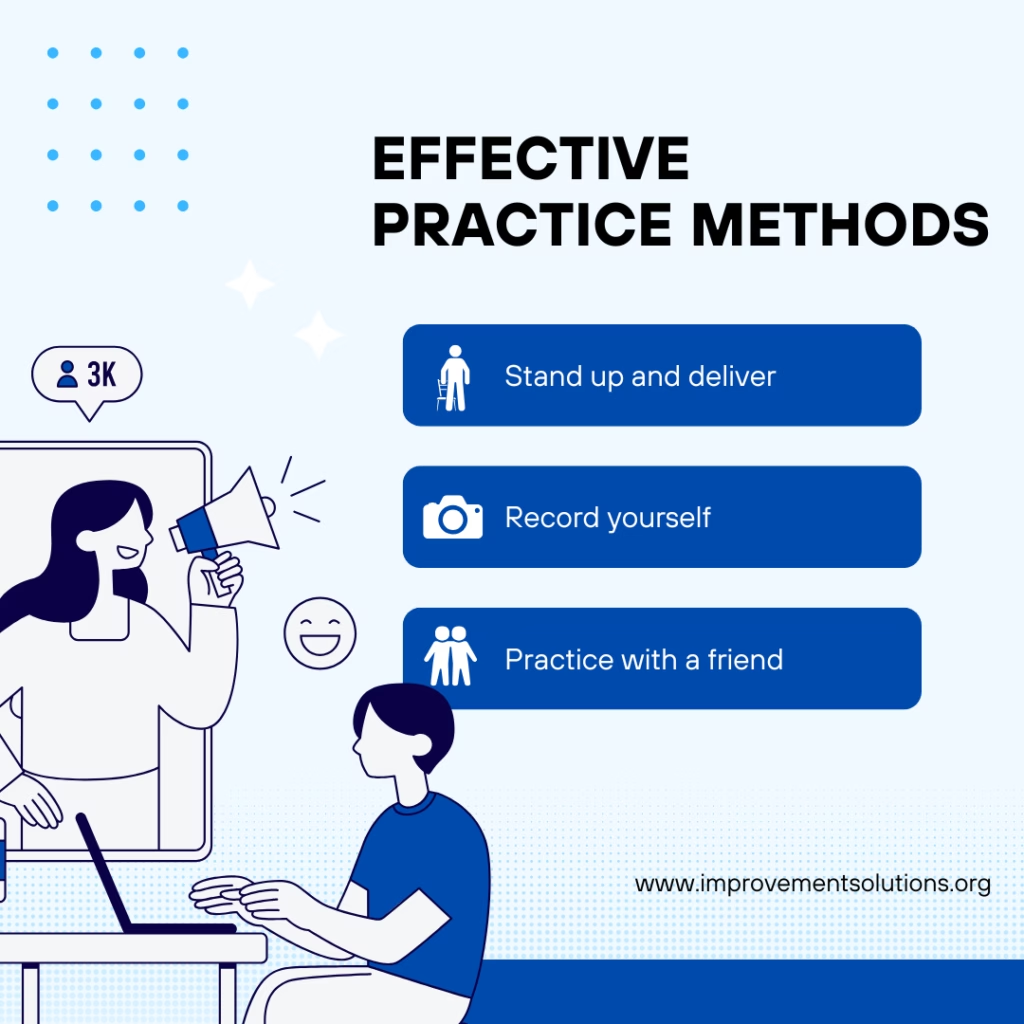
Working Your Way Up to Larger Audiences
Now, let’s talk about the big moment: stepping in front of an actual audience.
If you’re feeling nervous about presenting to a large group, the best way to work your way up is…baby steps.
Start by practicing in front of smaller groups.
Maybe it’s just a couple of friends, a small team meeting, or a virtual session with a coworker. The goal here is to build your comfort level so when you face a bigger crowd, it feels like just another step in the process.
For example, let’s say you’ve got a presentation to a room of 50 people coming up.
Don’t go from practicing in your bedroom to jumping straight into that 50-person presentation.
First, get comfortable talking in front of a few friends. Then try presenting to your department at work. Work your way up to larger groups as you get more comfortable.
As you build up, you’ll start to feel more natural in front of any audience.
And when the day comes to step in front of a larger crowd, you’ll have the confidence and skills to own it.
What Not to Practice
Alright, we’ve covered all the things you should practice, but now it’s time for a little reality check.
There are some things people obsess over during practice that, honestly, aren’t worth your time.
Here’s your what NOT to practice checklist:
- Perfecting every single word: Let’s be real, if you’re reading from a script word-for-word you’re setting yourself up for a whole lot of stress. Instead of focusing on memorizing every line, focus on understanding your main points and being flexible. If you get off track, just keep going. Your audience will never know the difference.
- Staring at your slides the entire time: A presentation isn’t about staring at a screen and reading off bullet points. Practice connecting with your audience instead. Make sure you’re engaging with the people in the room (or the camera, if you’re online) and not just glued to your slides.
- Obsessing over “perfection”: Newsflash: perfection is overrated. Don’t get hung up on every little detail. Is your hand gesture exactly the way you imagined? Does your voice have zero cracks? Forget about it. Just focus on being genuine and delivering your message clearly. The “perfect” presentation doesn’t exist and it doesn’t need to.
- Worrying About Every Single Filler Word : Okay, so we all drop a “um,” “like,” or “you know” here and there. But guess what? No one cares. Seriously. Don’t waste time stressing over every little verbal hiccup. Focus on the big picture: your content and how you engage with your audience. If you catch yourself saying “um” a lot, maybe cut down on those during your final practices—but don’t let it take over your practice time.
- Overloading on Technical Details: While you might have some fascinating stats or super detailed info to share, bombarding your audience with a bunch of numbers and technical jargon will likely cause them to zone out. Keep it simple. Focus on the big picture and only use detailed info when it’s necessary to back up your point. If you find yourself overloading on this, it’s time to pull back.

Handling Challenges
Here’s the truth: no matter how much you prepare or practice, some things are going to go wrong during your presentation.
That’s just part of the process.
But instead of panicking or stressing out, you can turn those challenges into opportunities to shine.
Let’s talk about how to handle those curveballs like a pro.
Recovering from Mistakes
Messing up during a presentation doesn’t mean you’ve failed; it means you’re human.
(Spoiler alert: your audience is full of humans, too.)
The trick is to not make it weird. Seriously. Most of the time, your audience won’t even notice a slip unless you draw attention to it. So instead of panicking or apologizing 37 times, try this:
Pause, take a breath, and keep going. A quick pause can reset your brain and give you a second to find your place again.
What to Do When You Lose Your Train of Thought
You’re in the zone, mid-sentence, and then… poof. Your brain bails on you.
Here’s how to get back on track without spiraling:
- Have anchor points. Before you present, know your main message and the key points that support it. That way, if you blank, you’ve got mental “checkpoints” to fall back on.
- Use your notes or slides (if you have them). They’re not a crutch, they’re a safety net.
Pro tip: Audiences are super forgiving when you’re honest and stay calm. It’s when we panic that things unravel.
Dealing with Difficult Questions or Audience Members
There’s always one person who either asks a 3-minute-long “question” (that’s actually a speech) or tries to play stump-the-speaker.
Step 1: Stay calm. Don’t let one person throw you off your game.
Step 2: Keep control. If a question is off-topic or derailing, say something like:
“That’s a great point! Let’s chat more about that after the presentation so we stay on track.”
And for tough questions you don’t know the answer to? No sweat. Try:
“That’s a thoughtful question, and I want to make sure I give you a thorough answer. Can I follow up with you afterward?”
Boom. You sound knowledgeable and thoughtful without pretending to be Google.
Technology Failures
Oh, tech. It’s amazing when it works and a total diva when it doesn’t.
PowerPoint crash? Mic cuts out? Video won’t play? First, take a breath. Then:
- Have a backup plan: Always bring printed notes or slides saved in a second format (like a PDF on your phone or USB).
- Keep talking: If your visuals go down, keep going with your message. Your words matter more than your slides.
- Address it with humor: “Looks like my slides are on a coffee break. Let’s keep rolling without them!”
Real talk: One time, the projector went out during a speech. I ended up sitting on the edge of the stage and just talking to the audience, TED-talk style. And you know what? It was one of the most engaged crowds I’ve ever had.
Frequently Asked Questions
We’ve covered a lot of ground, but I know there are always burning questions that still linger. So, let’s hit a few of the most common ones that tend to pop up when you’re preparing to present!
Should I Use Note Cards?
Oh, the age-old note card debate! The short answer: Yes, but use them wisely.
Note cards are a great tool if you need a safety net for key points or reminders. But here’s the trick: don’t rely too much on them.
You don’t want to be reading from them like it’s an autobiography.
Instead, keep them as a reference for your main ideas, and glance at them when necessary. You should know your content well enough that the note cards just give you a quick refresher, not a script to memorize.
Pro tip: If you’re using note cards, keep them numbered or organized in the right order so you’re not frantically flipping through pages when you lose your place!
How Long Should I Practice?
The magic number is different for everyone, but generally, aim for 3-5 full run-throughs before your actual presentation. This is how you build confidence and get comfortable with your material.
Here’s a breakdown:
- First practice: Work through the entire presentation, focusing on getting the flow right. Don’t worry too much about speed.
- Second practice: Time yourself and adjust your pacing. Aim for a pace that’s comfortable. No one wants a high-speed, high-stress speaker.
- Third practice: Record yourself. Trust me, this step will help you so much. You’ll catch things like filler words, awkward pauses, and pacing issues you never even noticed before.
- Fourth practice: Do it in front of someone! Whether it’s a friend, family member, or colleague, get feedback.
- Fifth practice: This one’s just for you to polish up anything that still feels a little off.
Remember: If you’re feeling overly rehearsed or too tight by your last practice, you’re probably ready to go. Memorizing can make you sound robotic, so aim to be confident, not perfect!
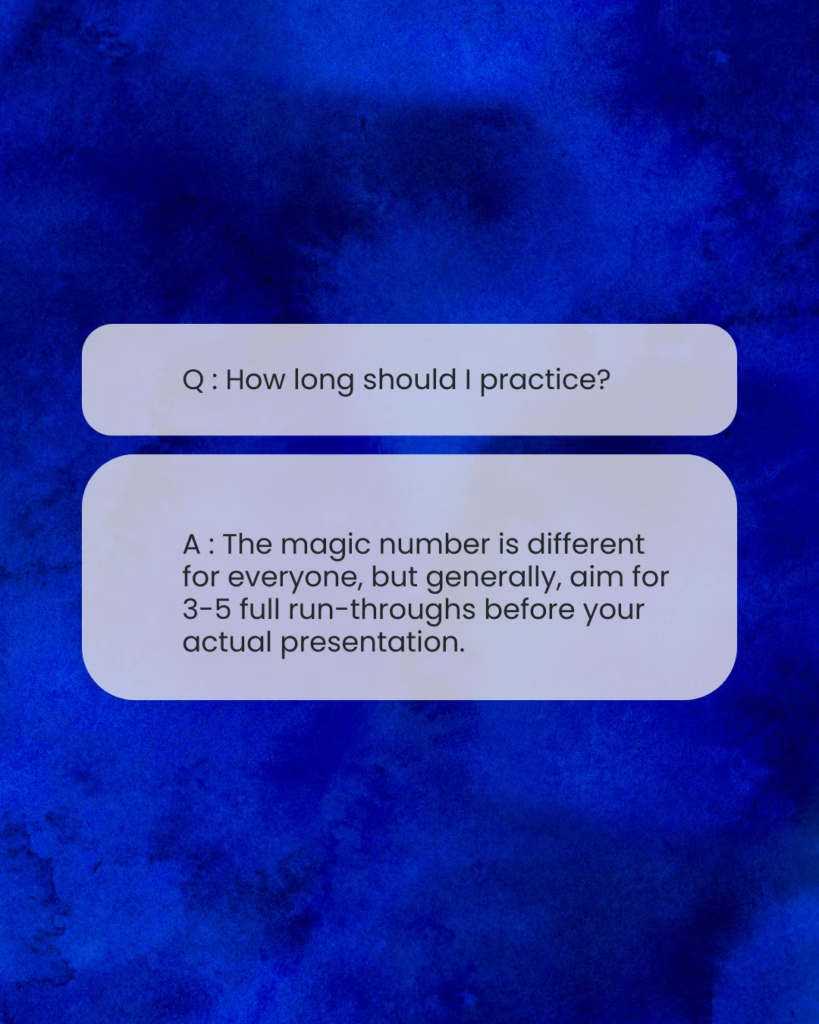
Is It Okay to Use Humor?
Absolutely!
Humor can be a fantastic way to connect with your audience to ease any nerves you might have. When done right, it lightens the mood, makes you more relatable, and gets everyone on your side.
But here’s the thing: keep it relevant.
Your audience came for your message, not a stand-up comedy routine (unless, of course, you’re doing a comedy presentation. Then, all bets are off!).
Example: Let’s say you’re presenting about productivity tips and you share that you once spent two hours organizing your pens instead of doing actual work. That relatable, lighthearted moment can make your audience laugh while also reinforcing the point that even the best of us get distracted.
How Do I Know If My Presentation Was Successful?
This is where the real magic happens. You might feel like you nailed it, but how do you know for sure? Here are a few signs you can look out for:
- Audience engagement: Did they seem engaged and interested? Were they taking notes, nodding, or asking questions? If they’re actively participating, you’re on the right track.
- Clarity: Were your key points clear and easy to follow? If you notice people aren’t struggling to keep up or are confused about your message, you’ve done a great job simplifying things.
- Feedback: If you can, ask for feedback after the presentation. You can ask for feedback in person or through a quick survey. Even if you get just a few key takeaways, it’ll help you tweak and improve for next time.
- How you felt: Did you feel like you were in the zone? If you felt confident, delivered your message smoothly, and had fun while doing it, chances are your audience felt that energy too.
And don’t forget, success isn’t just about getting through the presentation without a hitch. It’s about how well you connect, inspire, and share your message.
And there you have it!
From handling those pesky jitters to structuring your content like a pro, you’re now armed with the tools to make your next presentation a smashing success.
Remember, the key to effective public speaking isn’t about being perfect. It’s about being authentic and confident while engaging with your audience.
And hey, if you slip up along the way, it’s just part of the journey!
But, if you’re looking for extra guidance or a tailored approach to take your presentations to the next level, we’ve got your back.
At Continuous Improvement Solutions, we specialize in helping professionals like you sharpen their communication, presentation, and public speaking skills.
Whether you’re preparing for a big speech, tackling a client pitch, or just want to boost your confidence, we’re here to guide you every step of the way.
Ready to level up your presentation game?
Contact us today to schedule a session and start your journey to confident, impactful communication!
